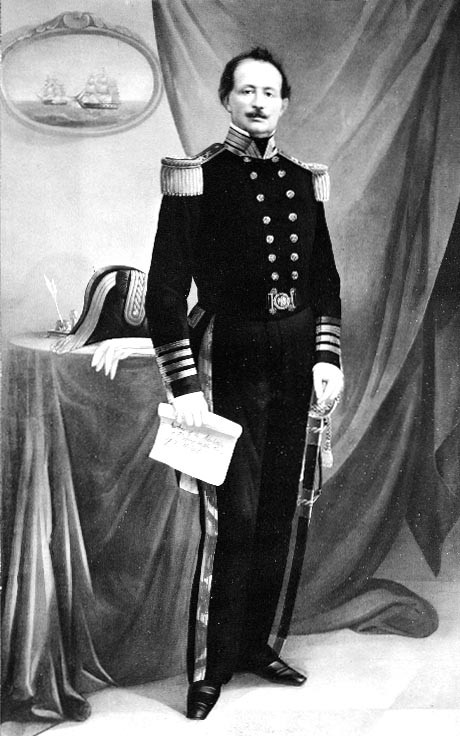IN THE SPRING OF 1842, Commander Uriah Levy found himself in a makeshift courtroom in Barnum’s City Hotel in Baltimore, facing a panel of five unsmiling naval officers. If this was a circus, Levy had been in center ring before. He holds the record for the most times a U.S. Navy officer has been hauled before a military tribunal: six courts-martial and two courts of inquiry.
Levy’s 1842 trial concerned the spectacle of punishment, homosexual liaisons among members of his crew, and the role of shame in the exposure of the male body. Mostly the case was about the male backside, about its context and symbolism, about a boy’s butt and how it differs from a man’s butt, about the legal delineation of the point in time when the juvenile gluteus maximus moves from the public sphere and becomes something a man possesses in his own right, a res with entitlements and protections. In the end, the court case was about ass cracks.
Uriah Levy was the only Jew of his rank in the Navy, and most of his court appearances were triggered by his refusal to accept the pointed anti-Semitism he encountered from his fellow officers. Judicial hearings frequently concluded that Levy had been intolerably provoked in his violent outbursts—yet he was still censured, kicked out of the Navy (and then reinstated), and passed over for plum assignments for which he was clearly qualified. When pressed, the Secretary of the Navy explained that, although he himself held no prejudice against people of the Hebrew faith, he needed to assemble crews that could work together:
I perceived a strong prejudice in the service against Capt. Levy, which seemed to me, in a considerable part attributable to his being of the Jewish persuasion; and while I as an executive officer had the same liberal views which guided the President and Senate, in commissioning him as a Capt., I always endeavored, in fitting out ships, to have some reference to that harmonious co-operation which is essential to the highest effectiveness.

The outrage that reached its climax at Barnum’s City Hotel began innocently enough. Onboard the sloop Vandalia, Midshipman Daniel Ammen gave an order to man the clew-garnets. A young sailor named John Thompson echoed the order, mimicking the midshipman’s voice to the amusement of his shipmates. Ammen did not hear the mocking, but Passed Midshipman James Doyle did, and he alerted his colleague that he was being mocked. Ammen, in turn, informed Captain Levy of the sailor’s insubordination.
It was a flogging offense, but Levy was personally reluctant to use corporal punishment on sailors unless it was absolutely necessary. Moreover, the Secretary of the Navy had issued a circular recommending that flogging be “discontinued where practicable” and be replaced by “some badge of disgrace, fine, &c.” Levy quickly devised an appropriate punishment. He ordered Thompson to drop his trousers and lean over a cannon. He then sent one of the ship’s boys to fetch some tar.
Here another sailor, named Van Ness, erupted in anger and attempted to halt the punishment. Thompson was Van Ness’s “chicken”—an arrangement whereby an older sailor provided protection and gifts to a younger shipmate in return for sexual favors. Van Ness made a violent attempt to protect his boyfriend’s buttocks from being exposed, but he was hauled away and given twelve lashes with a cat o’ nine tails.
When the boy returned with a piece of oakum dipped in tar, Levy ordered him to smear it on Thompson’s backside. A pet parrot aboard the ship had recently died, and the captain had some of its feathers plucked and inserted into the tar. He then told Thompson that he was teaching him a lesson about parroting officers. Thompson wore the “badge of disgrace” for about ten minutes, and then he was ordered to clean himself up and return to work.
That should have put an end to the matter, but unfortunately Commander Levy had made an enemy of Vandalia’s lieutenant, George Mason Hooe, who reported his superior officer to the Navy Department. Three years after the incident with the parrot feathers, Levy found himself in a Baltimore courtroom, charged with forgery, cowardice, and scandalous behavior—charges arising from three unrelated incidents in the past. The first two were easily dispensed with, but the third—the exposure of Thompson’s buttocks—raised too many explosive issues to be swept quietly away.
The officers of Vandalia who were called to testify described a shocking scene. John Thompson was a young man (their age estimates ranged from fifteen to twenty) who had been seized (tied) to one of the guns (whether by both hands or one hand they could not agree; perhaps his feet also, but perhaps not). The sailor had been stripped of his clothing, and forced by a rogue captain to expose his “seat of honor” (a common expression in the 19th century for a man’s rear end). Questioned by the Court concerning the amount of tar applied, responses ranged from “a small quantity” to “the general surface of the boy’s posteriors were rubbed over.”
Levy chose to call no witnesses in his defense but relied instead on a long written statement to present his case. He easily countered the charges of forgery and cowardice, and then turned his attention to the incident with Thompson, pointing out that he had merely followed the Navy’s own circular to substitute “badges of disgrace” wherever possible, and that the punishment, far from being unusually cruel, was actually milder than regulations permitted. “I admit my aversion to the free and constant use of the cat [o’ nine tails], much less lacerating the backs of boys of tender age, covering them with stripes and blood, and punishing them as hardened felons,” and so he took the kinder course.
Levy accused Lieutenant Hooe of recruiting spies to report on his activities, and in the process he made a surprising admission. Had the spies done their duty properly, Levy asserted, “they would have apprized him also, that I have a habit of spanking the boys instead of lashing their backs with a cat or a colt.” It was customary on ships to have the boatswain inflict corporal punishment. Levy had adopted a practice of having the boys spank one another while he watched.
After a brief deliberation, the court-martial panel found Levy not guilty of forgery or cowardice, but guilty of scandalous and cruel conduct unbecoming an officer and a gentleman, and he was dismissed from the Navy. As required, the verdict was sent to the President of the United States for his review, but after reading the testimony closely, John Tyler felt that the punishment was too severe, and ordered the court-martial to reassemble, this time focusing solely on the issue of Thompson’s backside.
Many of the witnesses who testified in the first hearing were recalled, but they were now pressed for more specific details. The Baltimore courtroom was no doubt a scene of great solemnity, with five stern judges in epaulettes and the court reporter with his steel nib scratching, but at times the verbatim transcript of the proceedings reads like middle-aged incels (involuntary celibates) having phone sex.
Question: Describe, if you please, how far Thompson’s pantaloons were down? What part of his person was exposed?
Answer: They were down as far as his hip bones, as near as I can recollect. I think about three fourths of his backside was exposed, as near as I can recollect.
Question: On what part of his person was the tar applied? Describe, as accurately as you can, the precise part? …
Question: State whether it is not customary in the Service to flog men on their backs, and boys on their bottoms? …
Question: When boys are flogged on their bottoms, are not their trousers let down, and their posteriors exposed?
For this rehearing, Levy called witnesses on his own behalf. The most effective was George Franks, who had been the wardroom steward, the servant employed to care for the officers’ quarters aboard Vandalia. Franks had read a newspaper account of the first trial and had written a letter to the editor in Levy’s defense, praising his treatment of the sailors under his command. On the witness stand Franks gave an informal but highly evocative account of Thompson’s reaction to the exposure. “In a few minutes the boy went forward laughing, got a little grease and wiped off the tar. I heard the boy laugh, and say, ‘I don’t care a pin about it.’ All the other boys laughed, and it was only a little fun. A pretty bad fellow, by the name of Van Ness, an Englishman, took occasion to say something impudent, and he was punished. This boy was a pet of Van Ness.”
The court then asked Franks a question that he declined to answer. This question and his response were redacted from the official transcript, and in their place appears a bracketed summary: “[The witness objected to answer this question, stating that having come here to testify about the boy Thompson, and for nothing else, and that he was a Citizen, that he was not here to testify about any private affairs—the Court told the witness that it was a proper question, and he answered it.]”
Almost certainly the question concerned the personal relationship between Van Ness and the young man he was flogged for protecting. Most of the officers called as witnesses were asked about Van Ness, and though they could remember in great detail the amount of tar and the exact position of Thompson’s trousers, when it came to the man who had violently intervened and was flogged for this disruption, they suffered from temporary amnesia. The only officer willing to discuss the sexual relationship between Van Ness and Thompson was the captain himself. “The mutinous language,” Levy explained to the court, “was only the language of Van Ness—a turbulent man, and whose chicken this boy was.”
The officers on the court-martial panel were irritated by President Tyler’s intervention and had reconvened solely on orders from the Commander-in-Chief. They listened to the new testimony but came to the same conclusion as before: Levy was guilty of scandalous behavior, and he was dismissed from the Navy. Their decision was again forwarded to President Tyler, who accepted the verdict but commuted the sentence to one year’s suspension without pay.
John Thompson never appeared at the trial, and his conspicuous absence is never accounted for. It is likely that in the three years between his punishment and Levy’s trial Thompson had left the Navy and disappeared into the vast stew of American youth on the move. He would presumably have been amused, though, that a commodore, five captains, nine ship’s officers, the Naval Judge Advocate, the Secretary of the Navy, and even the President of the United States had spent fourteen months judiciously establishing the precise significance of his naked posterior.
William Benemann is the author of Unruly Desires: American Sailors and Homosexualities in the Age of Sail, and Men in Eden: William Drummond Stewart and Same Sex Desire in the Rocky Mountain Fur Trade.





